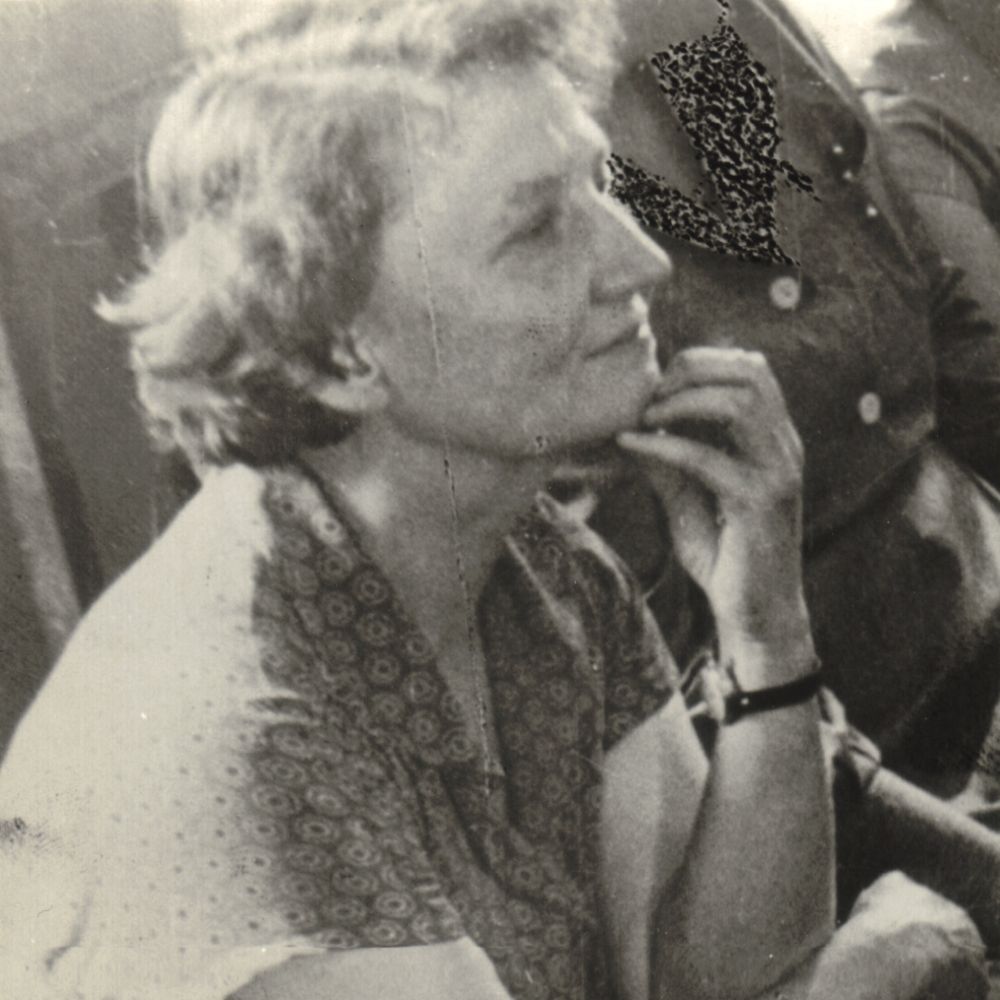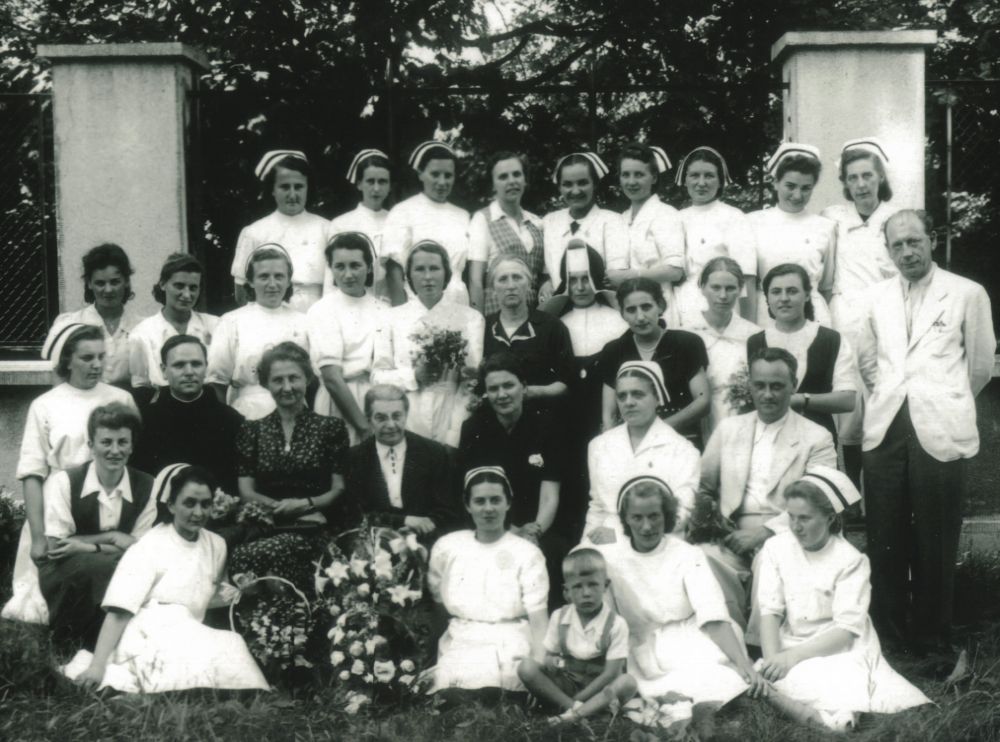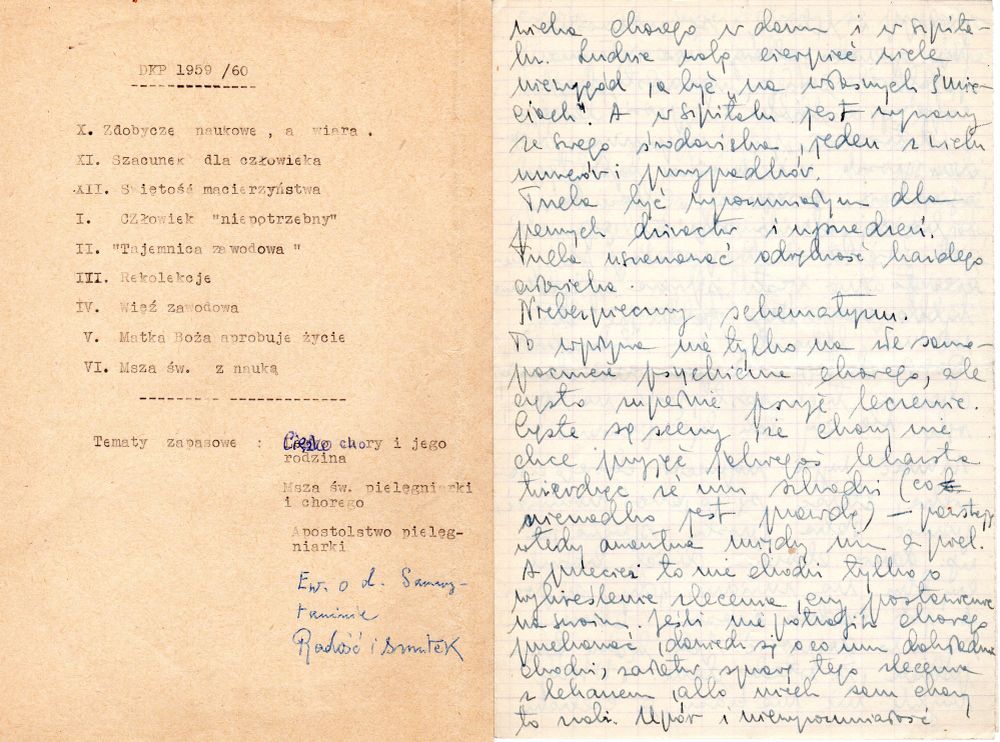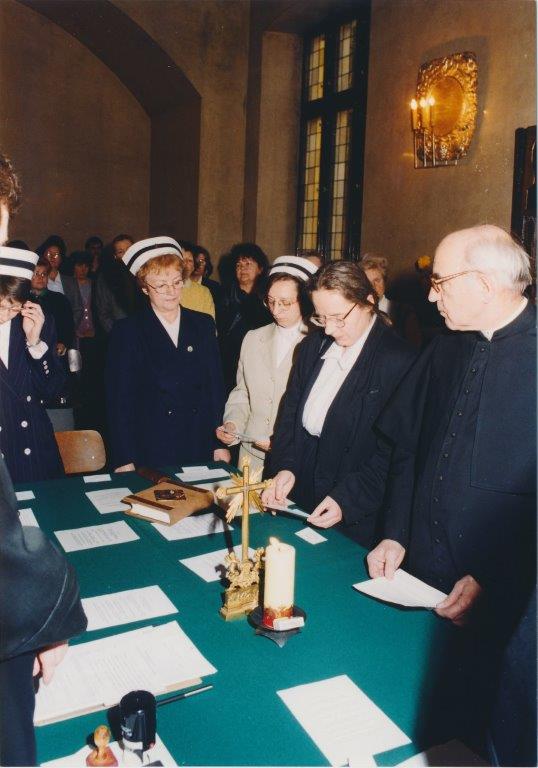Calendar:
life, work, beatification process
Life

- Born October 7, 1902 in Warsaw at ul. Senatorska 38, baptized in the parish church in Wiązowna. Father – Ignacy Chrzanowski, prof. Jagiellonian University, author of History of Literature of Independent Poland, mother – Wanda née Szlenkier. Brother Bohdan born September 26, 1900
- 1910 – the Chrzanowski family moves to Krakow, where the father – Ignacy Chrzanowski – takes over the Department of the History of Literature at the Jagiellonian University. Hanna’s studies at the boarding school of Miss Stanisława Okowiczówna at ul. Pańska in Krakow. Friendship with Anielka Chałubińska – granddaughter of Tytus Chałubiński.
- 1913-1914 – stay in Zakopane for medical purposes..
- 1915-1920 – studies at the Private Girls’ Secondary School of the Ursuline Sisters in Krakow, completed with a high school leaving exam.
- 1920 –participation in collections of clothes and food in Krakow homes for the war of 1920, help at the railway station, participation in nursing courses organized by the American Red Cross. Acquaintance with Stella Tylska, internship at the Surgical Clinic in Krakow – care of the injured.
- 1920-1922 – studies at the Faculty of Philosophy of the Jagiellonian University. Work at the Economics Women’s Dispensary founded by Maria Epstein.
- 1922-1924 – studies at the Warsaw School of Nursing directed by Helen Bridge. Diploma – June 1924
- 1925 – annual scholarship from the Rockefeller Foundation in Paris.
- 1926-1929 – work as a social nurse at the University School of Nurses and Hygienists in Krakow. Work in the Tuberculosis Clinic, Infant Clinic, and Pregnant Women’s Clinic. Scholarship from the Rockefeller Foundation in Belgium to learn about the work of a school nurse – hygienist.
- 1929 – several-month trip to a sanatorium in Switzerland.
- 1929-1939 – editor-in-chief of “Pielęgniarka Polska” – the magazine of the Polish Association of Professional Nurses. Author of 42 articles, including over 60 articles, including the “Kronika Nursing” and a review of domestic and foreign magazines.
- 1931-1933 – assistant to the director of the Warsaw School of Nursing.
- 1934 – the novel The Blue Key was published under the pseudonym Agnieszka Osiecka.
- 1935 – work on the Nursing Act.
- 1935 – work on the Nursing Act.
- 1938 – publishing, together with Teresa Kulczyńska, Nursing Treatments (published by the Polish Association of Professional Nurses). The book was reissued in 1938, 1943 (Książnica Polska Publishers in Glasgow), 1944 (Książnica Polska Publishers in Glasgow) and 1947 (PZWL). Publication of poems in “Myśla Narodowa”.
- 1938 – the novel was published under the pseudonym Agnieszka Osiecka. Cross on the sand. Stayed twice with my father in Italy.
- 1939-1945 r. – stay in Krakow. The death of brother Bohdan in Katyn in the spring of 1940. The imprisonment of Prof.’s father. Ignacy Chrzanowski as part of Sonderaction Krakau and deportation to the Sachsenhausen concentration camp. Death in January 1940. Forced relocation with his mother from the house of Jagiellonian University professors at al. Słowackiego 15 to the house at ul. Radziwiłłowska. Living together with Fery – Bohdan’s wife and their little daughter Wanda.
- Half. October 1939 – March 31. 1945 – work in the Section for Aid to Displaced Persons of the Polish Welfare Committee as the head of the home care department, and towards the end as the head of the Section.
- 1. IV. 1945-1. IX. 1957 – work at the State School of Nursing in Krakow as a training manager in open health care. Place of residence – University House, ul. Łobzowska 61.
- 1946 – 1947 – UNRA scholarship in the United States. Lectures during nursing training courses conducted on behalf of the Ministry of Health. Lectures on teaching methodology in open nursing at the School of Instructors in Warsaw.
- 1950 – a survey in schools all over Poland regarding training in the open nursing department, carried out at the request of the Ministry of Health. Participation in the work of the Polish Nursing Association, managing the historical subcommittee of the Krakow Branch.
- 1951-1957 – function of deputy director of the State Nursing School in Krakow.
- 1951 – death of mother, Wanda.
- 1953 – participation in services at the Tyniec Abbey.
- 1955 – beginning of conferences and retreats for nurses.
- 1957 – the beginning of parish nursing.
- 1957 – establishment of the Polish Nursing Association, work on the Main Board and then on the Historical Committee of the Polish Nursing Association.
- l. IX. 1957 -30. VI. 1958 – director of the School of Psychiatric Nursing in Kobierzyn.
- 1957 – badge “For exemplary work in the Health Service”.
- 1958 – transition to a teacher’s pension.
- 1960s – deputy spokesman for the health service.
- 1960 – Publication of Nursing in Open Health Care, PZWL.
- 1964 – the beginning of nursing courses for nuns organized under the patronage of the Krakow curia.
- 1964 – beginning of retreat for the sick in the xx Retreat House. Salvatorians in Trzebinia (lasted until 1984, then in the years 1984 – 1989 in Kalwaria Zebrzydowska at the 00. Bernardynów, Nowa Wieś until 1994).
- 1964 – Nursing in Open Health Care, PZWL, 2nd edition.
- 21. XII. 1965 r. – Order “Pro Ecclesia et Pontifice” from Pope Paul VI
- “Nursing in Open Health Care”, PZWL, 3rd edition.
- 1966 – surgery at the Gynecology Clinic at ul. Copernicus. Radiation and X-ray exposure.
- 1971 – the beginning of two-week retreats for the sick in Staniątki with the Benedictine Sisters.
- 17. XII. – Knight’s Cross of the Order of Polonia Restituta.
- 1973 – Nursing in Open Health Care, PZWL, 4th edition, supplemented and corrected, (together with Kazimiera Skobyłko, then subsequent editions in 1975 and 1976).
- 29. IV. 1973 – death of Hanna Chrzanowska.
- 2. V. 1973 – funeral of Hanna Chrzanowska at the Rakowicki cemetery led by Cardinal Karol Wojtyła.
- 3. XI. 1998 – beginning of the beatification process.
„The face was once beautiful. Hair once blonde.
Education: lower. Occupation: charwoman and everything’s go-between.
Personality: a cheerful miser and a penny-pincher. Interests: Kobra and Synod.“
– Hanna Chrzanowska about yourself, 1973
Work
Education and professional preparation:

- In the scope of primary school – home teaching and studying on Mrs. Okołowiczówna’s boarding school in Krakow.
- Ursuline Secondary School in Krakow, with the high school leaving exam in 1920.
- A sanitary course conducted by American Red Cross nurses, entitling them to care for wounded soldiers during the Bolshevik War.
- Volunteer at the outpatient clinic. A steward’s office where dressings were made for the poor.
- 1920 – 1921 Studies at the Faculty of Polish Studies at the Jagiellonian University (UJ).
- 1922 – 1924 Studying at the Warsaw School of Nursing
- 1924 One semester at the Faculty of Polish Studies at the Jagiellonian University.
- 1925 – 1926 One-year stay in France as part of a scholarship from the Rockefeller Foundation in the field of social nursing.
- 1926 Month-long stay in Belgium as part of a scholarship from this foundation in the field of school hygiene.
- 1946 – 1947 Half-year stay in New York, with a group of Polish nurses as part of a UNRRA (United Nations Relief and Rehabilitation Administration) scholarship, during which she became familiar with the organization and methodology of home nursing in the USA.
Teaching work and functions:

- 1926 – 1929 Work as an instructor of Social Nursing and Public Health at the University School of Nurses and Hygienists (USPiH) in Krakow at ul. Copernicus.
- 1929 – 1939 He was the Chief Editor of the professional monthly “Pielęgniarka Polska”.
- 1931 – 1933 assistant to the director of the Warsaw School of Nursing.
- Working in the team preparing the Act on the Nursing Profession, approved by the Sejm of the Republic of Poland in 1935.
- 1936 – 1937 Elected vice-president of the Polish Association of Vocational Nurses during subsequent congresses.
- 1939 – 1945 work in the Department for the Care of Refugees and Displaced Persons in Krakow – training nurses to care for the wounded and volunteers to work with refugees.
- Child care, adoption of orphans.
- Od 1945 lectures at the courses of the sisters of the Polish Red Cross Sanitary Emergency Service in Krakow.
- Cooperation with Anna Rydlówna in creating the school program at the Seraphite Sisters’ Nursing School in Przemyśl.
- 1945 – 1957 At the USPiH, and after the transformation into the National School of Nursing – head of training in open treatment, implementation of Home Nursing teaching along with internships and the function of deputy director of the school.
- Until 1950, lectures at the Catholic School of Nursing of the Sisters of Mercy of St. Vincent de Paul in Krakow.
- 1957 – 1958 Duties of the director of the Neuropsychiatric School in Kobierzyn.
- Since the post-war years, at the request of the Ministry of Health, she has been a lecturer at the School of Instructors in the field of teaching methodology in open health care.
- June 1957 Implementation of care for the sick at home as part of the Parish Nursing, operating according to a program prepared by H. Chrzanowska. The program included: Long-term care, home hospice, terminal care.
- Development of a program of three-month courses for nuns who were deprived of the opportunity to receive education by the authorities of the Polish People’s Republic.
- Further education lectures for nurses in various Polish cities.
- 1957 after the establishment of the Polish Nursing Association (PTP), work on the Main Board and long-time chairwoman of the Historical Commission in Warsaw and Kraków.
- Since the 60s he has been working as a deputy spokesman for health care at the District Professional Control Commission in Krakow.
- Participation in consultations during work on the organization of community nursing.
- Cooperation with Teresa Kulczyńska in the scope of consultations during the creation of the Faculty of Nursing in Lublin.
“Although our work constantly places emphasis on strictly nursing services, we must not forget for a moment that services for the psyche and soul of the patient are inextricably linked with them. Only their combination constitutes the essence of nursing from a Christian perspective. To serve in this spirit is to draw from the source of joy.”
Ethical issues in home nursing. The essence of work.
– Hanna Chrzanowska
Publications and studies:

- Literary attempts – two novels published under the pseudonym Agnieszka Osiecka and several poems
- The novel “Blue Key” (1934), “Cross on the Sand” (1938), the unpublished third novel “Burning Snow” left without specifying the date of its creation.
- In the years 1929-1939, she was the editor-in-chief of the professional monthly “Pielęgniarka Polska”, where she published many of her great articles. She kept a chronicle and review of domestic and foreign magazines on nursing around the world.
- Under her editorship, “Nursing Treatments” (1938) were published, based on the notes of Mrs. Teresa Kulczyńska. Previously printed in Nurse Polska, they were further published in Poland, during the war in Glasgow, and in post-war Poland.
- “Guidelines for the work of a social nurse”, including work in individual clinics, printed periodically in the years 1938 – 1939. Developed together with nurse Wanda Lankajtes.
- The textbook “Nursing in Open Health Care” published in 1960, 1964, 1966. The fourth revised edition of the textbook, with elements of community nursing, written in cooperation with instructor Kazimiera Skobyłko, was published by H. Chrzanowska in 1972. However, the manual was published after Chrzanowska’s death at the end of 1973.
- Unpublished ethical issues in home nursing, long-term and terminal care.
- 1970. Unpublished “Guidelines for the work of caregivers of the sick in parish care”.
- “Regulations of the parish caregiver for the sick”, approved by Fr. Cardinal Karol Wojtyła in 1971.
- A large number of papers, training outlines, CVs, and texts of other speeches.
- Articles in “Tygodnik Powszechny” and “Nurse and Midwife”.
- Corrections of master’s theses and the PCK Instructor’s Manual.
- Unpublished Memoir (manuscript, typescript). It was published in 2018.
Beatification process – calendar

- April 1993 After Holy Mass celebrated in the Franciscan Basilica by Fr. Bishop Stanisław Smoleński, on the 20th anniversary of the death of Hanna Chrzanowska, among the gathered nurses, patients and their caregivers, a request was made to initiate the beatification process of Hanna Chrzanowska. The application was submitted by nurse Zofia Szlendak-Cholewińska.
- December 4, 1995 During the canonical visitation of the Parish of St. Nicholas in Krakow by HE Fr. Cardinal Franciszek Macharski, after a meeting with representatives of the Health Service, the Board of the Branch of the Catholic Association of Polish Nurses and Midwives with its president Izabela Ćwiertnia, the pastor of nurses and midwives, Fr. Kazimierz Kubik, turned to Fr. Cardinal with a request to initiate efforts to elevate Hanna Chrzanowska to the altars.
- March 1997 Polish bishops gathered at the 287th Polish Episcopal Conference expressed a positive opinion on the appropriateness of initiating the process.
- Appointment by Fr. Cardinal F. Macharski of the Historical Commission chaired by prof. Ph.D. Urszula Perkowska and members: nurses: Krystyna Pęchalska and Maria Przybylska.
- October 1998 Completion of the work of the Historical Commission. Approximately 3,000 pages of documents were collected. Parish priest of St. Nicholas Fr. Prelate Antoni Sołtysik asked the Cardinal in an official letter to open the beatification process of Hanna Chrzanowska.
- On November 3, 1998, HE Cardinal Franciszek Macharski, by issuing a decree, solemnly opened the beatification process. The swearing in of the Tribunal took place in the chapel of the Archbishops of Krakow. The ceremony was performed by the Cardinal in the presence of the appointed official for canonization, Father Prof. hab. Stefan Ryłko. Assistants to Fr. Andrzej Skąber and Fr. Andrzej Grodecki. Father Antoni Sołtysik – parish priest of St. – was sworn in as a postulator. Nicholas, vice-postulator – nurse Helena Matoga, notary lawyer, nurse Maria Cherian.
- May 1999 In the church of St. Nicholas in Krakow, every third Wednesday of the month, there are prayers for the elevation of Hanna Chrzanowska to the altars. It is also a day of formation meetings for nurses and midwives.
- The interrogation of witnesses of the life and work of the Servant of God Hanna Chrzanowska has begun. Over 72 people were interrogated.
- December 30, 2002. Solemn closing of the beatification process at the diocesan level of the Servant of God Hanna Chrzanowska by HE Fr. Cardinal F. Macharski.
- January 30, 2003. Transmission of procedural documents to the Congregation for the Cult of Saints of the Holy See. Fr was elected Roman postulator of the beatification process. Prelate Mieczysław Niepsuj, director of the Polish House in Rome. The documents were provided by: Fr. Postulator Antoni Sołtysik with Fr. Kazimierz Kubik.
- The development of POSITIO began – accounts of life, heroic virtues, testimonies of witnesses, ultimately containing 700 pages.
- On September 30, 2015, during an audience in the Vatican for the Prefect of the Congregation for the Causes of Saints, Cardinal. Angelo Amato, Pope Francis confirmed the decrees on the heroic virtues of the Servants of God, Fr. Franciszek Blachnicki and nurse Hanna Chrzanowska.
- On April 6, 2016, the mortal remains of the Venerable Servant of God were moved from the Rakowicki Cemetery to the crypt of the Church of St. Nicholas in Krakow at ul. Kopernika 9.
- July 7, 2017. Approval by Pope Francis of the beatification decree of the Venerable Servant of God Hanna Chrzanowska. The basis was that the miracle was caused by the Servant of God.
- On December 7, 2017, the Decree was issued by His Excellency. priest Metropolitan Archbishop of Krakow Marek Jędraszewski, appointing the Organizing Committee to prepare the beatification ceremony scheduled for April 28, 2018, on the eve of the 45th anniversary of the death of the Servant of God. As part of the preparation for beatification, on the 28th day of each month in the church of St. Nicholas, a solemn Holy Mass was held. followed by thematic conferences presenting the life and work of the future candidate for altars. J.Ex. priest Archbishop Marek Jędraszewski dedicated the second part of the Jubilee Novena to Blessed Hanna Chrzanowska, expressing thanksgiving for the regained independence of our homeland. He pointed to remembering her figure during sermons, especially during Lent and the Paschal Triduum, as well as at meetings of charity groups and volunteer teams.
- On April 4, 2018, the coffin with the remains of the future blessed was carried in a procession from the crypt to the marble sarcophagus placed under the historic triptych in the side nave of the church of St. Nicholas. The procession was led by J. Ex. Bishop Jan Zając. Those participating in the ceremony sang the litany to All Saints.
- April 28, 2018. Beatification ceremony at the Sanctuary of Divine Mercy in Łagiewniki. The legate of Pope Francis, Cardinal Angelo Amato, read the Papal Decree and delivered a sermon dedicated to the new Blessed. The patronal feast in honor of the Blessed was scheduled for April 28.

